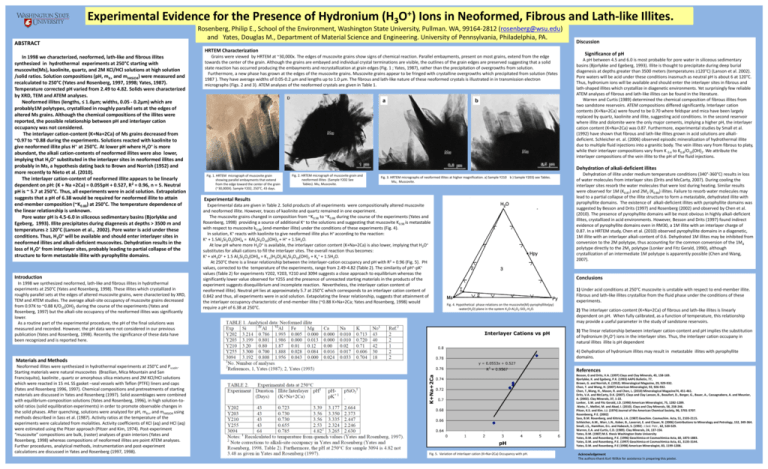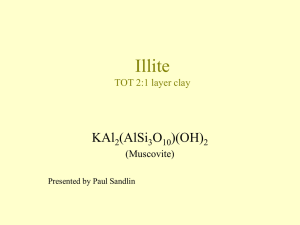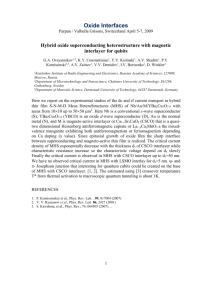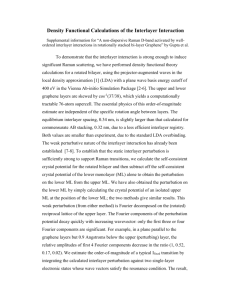Poster-Rosenberg GSA 2013 final
advertisement

Experimental Evidence for the Presence of Hydronium (H3 ABSTRACT + O) Ions in Neoformed, Fibrous and Lath-like Illites. Rosenberg, Philip E., School of the Environment, Washington State University, Pullman. WA, 99164-2812 (rosenberg@wsu.edu) and Yates, Douglas M., Department of Material Science and Engineering. University of Pennsylvania, Philadelphia, PA. HRTEM Characterization In 1998 we characterized, neoformed, lath-like and fibrous illites synthesized in hydrothermal experiments at 250°C starting with muscovite(Ms), kaolinite, quartz, and 2M KCl/HCl solutions at high solution /solid ratios. Solution compositions (pH, mK+ and mH4SiO4) were measured and recalculated to 250°C (Yates and Rosenberg, 1997, 1998; Yates, 1987). Temperature corrected pH varied from 2.49 to 4.82. Solids were characterized by XRD, TEM and ATEM analyses. Neoformed illites (lengths, ≤ 1.0µm; widths, 0.05 - 0.2µm) which are probably1M polytypes, crystallized in roughly parallel sets at the edges of altered Ms grains. Although the chemical compositions of the illites were reported, the possible relationship between pH and interlayer cation occupancy was not considered. The interlayer cation-content (K+Na+2Ca) of Ms grains decreased from ~0.97 to ~0.88 during the experiments. Solutions reacted with kaolinite to give neoformed illite plus H+ at 250°C. At lower pH where H3O+ is more abundant, the alkali cation-contents of neoformed illites were also lower, implying that H3O+ substituted in the interlayer sites in neoformed illites and probably in Ms, a hypothesis dating back to Brown and Norrish (1952) and more recently to Nieto et al. (2010). The interlayer cation-content of neoformed illite appears to be linearly dependent on pH: (K + Na +2Ca) = 0.055pH + 0.527, R2 = 0.96, n = 5. Neutral pH is ~ 5.7 at 250°C. Thus, all experiments were in acid solution. Extrapolation suggests that a pH of 6.38 would be required for neoformed illite to attain end-member composition (~K0.88) at 250°C. The temperature dependence of the linear relationship is unknown. Pore water pH is 4.5-6.0 in siliceous sedimentary basins (Bjorlykke and Egeberg, 1993). Illite precipitates during diagenesis at depths > 3500 m and temperatures ≥ 120°C (Lanson et al., 2002). Pore water is acid under these conditions. Thus, H3O+ will be available and should enter interlayer sites in neoformed illites and alkali-deficient muscovites. Dehydration results in the loss of H3O+ from interlayer sites, probably leading to partial collapse of the structure to form metastable illite with pyrophyllite domains. Introduction In 1998 we synthesized neoformed, lath-like and fibrous illites in hydrothermal experiments at 250°C (Yates and Rosenberg, 1998). These illites which crystallized in roughly parallel sets at the edges of altered muscovite grains, were characterized by XRD, TEM and ATEM studies. The average alkali-site occupancy of muscovite grains decreased from 0.97K to ~0.88 K/O10(OH)2 during the course of the experiments (Yates and Rosenberg, 1997) but the alkali-site occupancy of the neoformed illites was significantly lower. As a routine part of the experimental procedure, the pH of the final solutions was measured and recorded. However, the pH data were not considered in our previous publication (Yates and Rosenberg, 1998). Recently, the significance of these data have been recognized and is reported here. Grains were viewed by HRTEM at ~30,000x. The edges of muscovite grains show signs of chemical reaction. Parallel embayments, present on most grains, extend from the edge towards the center of the grain. Although the grains are embayed and individual crystal terminations are visible, the outlines of the grain edges are preserved suggesting that a solid state reaction has occurred producing the embayments and recrystallization at grain edges (Fig. 1 ; Yates, 1987), rather than the precipitation of overgrowths from solution. Furthermore, a new phase has grown at the edges of the muscovite grains. Muscovite grains appear to be fringed with crystalline overgrowths which precipitated from solution (Yates 1987 ). They have average widths of 0.05-0.2 µm and lengths up to 1.0 µm. The fibrous and lath-like nature of these neoformed crystals is illustrated in in transmission electron micrographs (Figs. 2 and 3). ATEM analyses of the neoformed crystals are given in Table 1. a b Significance of pH A pH between 4.5 and 6.0 is most probable for pore water in siliceous sedimentary basins (Bjorlykke and Egeberg, 1993). Illite is thought to precipitate during deep burial diagenesis at depths greater than 3500 meters (temperatures ≥120°C) (Lanson et al. 2002). Pore waters will be acid under these conditions inasmuch as neutral pH is about 6 at 120°C. Thus, hydronium ions will be available and should enter the interlayer sites in fibrous and lath-shaped illites which crystallize in diagenetic environments. Yet surprisingly few reliable ATEM analyses of fibrous and lath-like illites can be found in the literature. Warren and Curtis (1989) determined the chemical composition of fibrous illites from two sandstone reservoirs. ATEM compositions differed significantly. Interlayer cation contents (K+Na+2Ca) were found to be 0.70 where feldspar and mica have been largely replaced by quartz, kaolinite and illite, suggesting acid conditions. In the second reservoir where illite and dolomite were the only major cements, implying a higher pH, the interlayer cation content (K+Na+2Ca) was 0.87. Furthermore, experimental studies by Small et al. (1992) have shown that fibrous and lath-like illites grown in acid solutions are alkalideficient. Schleicher et. al. (2006) observed episodic mineralization of hydrothermal illite due to multiple fluid injections into a granitic body. The vein illites vary from fibrous to platy, while their interlayer compositions vary from K 0.4 to K0.8/O10(OH)2. We attribute the interlayer compositions of the vein illite to the pH of the fluid injections. Dehydration of alkali-deficient illites Fig. 1. HRTEM micrograph of muscovite grain showing parallel embayments that extend from the edge toward the center of the grain (~30,000X). Sample Y202, 250°C, 43 days. Fig. 2. HRTEM micrograph of muscovite grain and neoformed illites (Sample Y202 See Tables). Mu, Muscovite. Fig. 3. HRTEM micrographs of neoformed illites at higher magnification. a) Sample Y210 b ) Sample Y203) see Tables. Mu, Muscovite. Experimental Results Experimental data are given in Table 2. Solid products of all experiments were compositionally altered muscovite and neoformed illite. However, traces of kaolinite and quartz remained in one experiment. The muscovite grains changed in composition from ~K0.98 to ~K0.88 during the course of the experiments (Yates and Rosenberg, 1998) providing a source of additional K+ to the solutions and suggesting that muscovite K0.98 is metastable with respect to muscovite k0.88 (end-member illite) under the conditions of these experiments (Fig. 4). In solution, K+ reacts with kaolinite to give neoformed illite plus H+ according to the reaction: K+ + 1.5Al2Si2O5(OH)4 = KAl3Si3O10(OH)2 + H+ + 1.5H2O. At low pH where more H3O+ is available, the interlayer cation content (K+Na+2Ca) is also lower, implying that H3O+ substitutes for alkali cations to fill the interlayer sites. The overall reaction thus becomes: K+ + xH3O+ + 1.5 Al2Si2O5(OH)4 = K1-x(H3O)xAl3Si3O10(OH)2 + Kx+ + 1.5H2O. At 250°C there is a linear relationship between the interlayer-cation occupancy and pH with R2 = 0.96 (Fig. 5}. PH values, corrected to the temperature of the experiments, range from 2.49-4.82 (Table 2). The similarity of pH+-pK+ values (Table 2) for experiments Y202, Y203, Y210 and 3094 suggests a close approach to equilibrium whereas the significantly lower value observed for Y255 and the presence of unreacted starting materials in the products of the experiment suggests disequilibrium and incomplete reaction. Nevertheless, the interlayer cation content of neoformed illite). Neutral pH lies at approximately 5.7 at 250°C which corresponds to an interlayer cation content of 0.842 and thus, all experiments were in acid solution. Extapolating the linear relationship, suggests that attainment of the interlayer occupancy characteristic of end-member illite (~0.88 K+Na+2Ca; Yates and Rosenberg, 1998) would require a pH of 6.38 at 250°C. Dehydration of illite under medium temperature conditions (340°-360°C) results in loss of water molecules from interlayer sites (Drits and McCarty, 2007). During cooling the interlayer sites resorb the water molecules that were lost during heating. Similar results were observed for 1M (K0.87) and 2M2 (K0.86) illites. Failure to resorb water molecules may lead to a partial collapse of the illite structure to form a metastable, dehydrated illite with pyrophyllite domains. The existence of alkali-deficient illites with pyrophyllite domains was suggested by Besson and Drits (1997) and Rosenberg (2002) and observed by Chen et al. (2010). The presence of pyrophyllite domains will be most obvious in highly alkali-deficient illites, crystallized in acid environments. However, Besson and Drits (1997) found indirect evidence of pyrophyllite domains even in RM30, a 1M illite with an interlayer charge of 0.87. In a HRTEM study, Chen et al. (2010) observed pyrophyllite domains in a diagenetic, 1M illite with an interlayer alkali-content of 0.6. Dehydrated 1M illites may be inhibited from conversion to the 2M polytype, thus accounting for the common conversion of the 1Md polytype directly to the 2M1 polytype (Lonker and Fitz Gerald, 1990), although crystallization of an intermediate 1M polytype is apparently possible (Chen and Wang, 2007). Conclusions Fig. 4. Hypothetical phase relations on the muscovite(M)-pyrophylllite(py) -water(H2O) plane in the system K2O-Al2O3-SiO2-H2O. 1) Under acid conditions at 250°C muscovite is unstable with respect to end-member illite. Fibrous and lath-like illites crystallize from the fluid phase under the conditions of these experiments. 2) The interlayer cation-content (K+Na+2Ca) of fibrous and lath-like illites is linearly dependent on pH. When fully calibrated, as a function of temperature, this relationship may provide a useful parameter in the study of sandstone reservoirs. 3) The linear relationship between interlayer cation-content and pH implies the substitution of hydronium (H3O+) ions in the interlayer sites. Thus, the interlayer cation occupany in natural illites illite is pH dependent 4) Dehydration of hydronium illites may result in metastable illites with pyrophyllite domains. Materials and Methods Neoformed illites were synthesized in hydrothermal experiments at 250°C and Pv.soln. Starting materials were natural muscovites (Brazilian, Mica Mountain and San Francisquito), kaolinite , quartz or amorphous silica mixtures and 2M KCl/HCl solutions which were reacted in 15 mL SS gasket –seal vessels with Teflon (PTFE) liners and caps (Yates and Rosenberg 1996, 1997). Chemical compositions and pretreatments of starting materials are discussed in Yates and Rosenberg (1997). Solid assemblages were combined with equilibrium-composition solutions (Yates and Rosenberg, 1996), in high solution-tosolid ratios (solid equilibration experiments) in order to promote observable changes in the solid phases. After quenching, solutions were analyzed for pH, mK+, and mH4SiO4 using methods described in Sass et al. (1987). Activity ratios at the temperature of the experiments were calculated from molalities. Activity coefficients of KCl (aq) and HCl (aq) were estimated using the Pitzer approach (Pitzer and Kim, 1974). Post-experiment “muscovite” compositions are bulk, (raster) analyses of grain interiors (Yates and Rosenberg, 1998) whereas compositions of neoformed illites are point ATEM analyses. Further procedures, analytical methods, instrumentation and post-experiment calculations are discussed in Yates and Rosenberg (1997, 1998). Discussion References Besson, G and Drits, V.A. (1997) Clays and Clay Minerals, 45, 158-169. Bjorlykke, K. and Egeberg, P.K. (1993) AAPG Bulletin, 77, Brown, G. and Norrish, K. (1952). Mineralogical Magazine, 29, 929-932. Chen, T. and Wang, H. (2007) American Mineralogist, 92, 926-932. Chen, T.,Wang, H., Mason, R. and Chen, L. (2010) Mineralogical Magazine74, 451-461. Drits, V.A. and McCarty, D.K. (2007). Clays and Clay Lanson, B., Beaufort, D., Berger, G., Bauer, A., Cassagnabere, A. and Meunier, A. (2002). Clay Minerals, 37, 1-22. Lonker, S.W. and Fitz Gerald, J.D. (1990) American Mineralogist, 75, 1282-1289. .Nieto, F., Mellini, M. and Abad, I. (2010). Clays and Clay Minerals, 58, 238-246. Pitzer, K.S. and Kim. J.J. (1974) Journal of the American Chemical Society, 96, 5701-5707. Rosenbeerg, P.E. (2002) Sass, B.M. Rosenberg, and Kittrick, J.A. (1987) Geochim. Cosmochim. Acta, 51, 2103-2115. Schleicher, A.M., Warr, L.N., Kober, B., Laverret, E. and Clauer, N. (2006) Contributions to Mineralogy and Petrology, 152, 349-364. Small, J.S,, Hamilton, D.L. and Habesch, S. (1992). J.Sed. Petr., 62, 520-529. Warren, E.A. and Curtis, C.D. (1989). Clay Minerals, 24, 137-156. Yates, D.M. (1987) M.S. thesis Washington State University Yates, D.M. and Rosenberg, P.E. (1996) Geochimica et Cosmochimica Acta, 60, 1873-1883. Yates, D.M. and Rosenberg, P.E. (1997) Geochimica et Cosmochimica Acta, 61, 3135-3144. Yates, D.M. and Rosenberg, P.E (1998) American Mineralogist, 83, 1199-1208. Fig. 5. Variation of interlayer cation (K+Na+2Ca) Occupancy with pH. Acknowledgement The authors thank Kurt Wilkie for assistance in preparing this poster.




